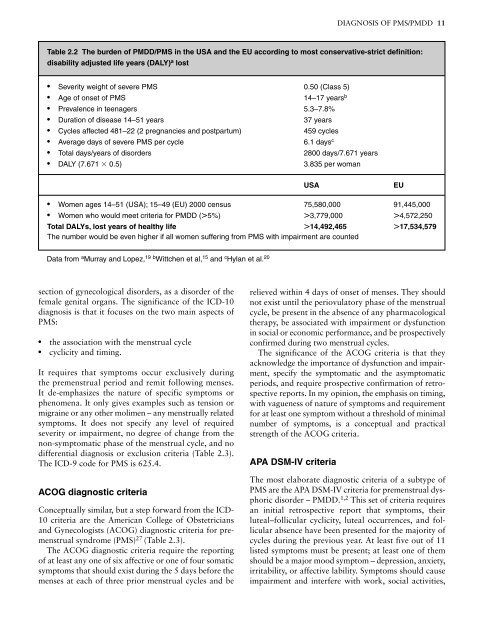Premenstrual Syndromes : PMS and PMDD - Rutuja :: The site ...
Premenstrual Syndromes : PMS and PMDD - Rutuja :: The site ...
Premenstrual Syndromes : PMS and PMDD - Rutuja :: The site ...
You also want an ePaper? Increase the reach of your titles
YUMPU automatically turns print PDFs into web optimized ePapers that Google loves.
section of gynecological disorders, as a disorder of the<br />
female genital organs. <strong>The</strong> significance of the ICD-10<br />
diagnosis is that it focuses on the two main aspects of<br />
<strong>PMS</strong>:<br />
● the association with the menstrual cycle<br />
● cyclicity <strong>and</strong> timing.<br />
It requires that symptoms occur exclusively during<br />
the premenstrual period <strong>and</strong> remit following menses.<br />
It de-emphasizes the nature of specific symptoms or<br />
phenomena. It only gives examples such as tension or<br />
migraine or any other molimen – any menstrually related<br />
symptoms. It does not specify any level of required<br />
severity or impairment, no degree of change from the<br />
non-symptomatic phase of the menstrual cycle, <strong>and</strong> no<br />
differential diagnosis or exclusion criteria (Table 2.3).<br />
<strong>The</strong> ICD-9 code for <strong>PMS</strong> is 625.4.<br />
ACOG diagnostic criteria<br />
Conceptually similar, but a step forward from the ICD-<br />
10 criteria are the American College of Obstetricians<br />
<strong>and</strong> Gynecologists (ACOG) diagnostic criteria for premenstrual<br />
syndrome (<strong>PMS</strong>) 27 (Table 2.3).<br />
<strong>The</strong> ACOG diagnostic criteria require the reporting<br />
of at least any one of six affective or one of four somatic<br />
symptoms that should exist during the 5 days before the<br />
menses at each of three prior menstrual cycles <strong>and</strong> be<br />
DIAGNOSIS OF <strong>PMS</strong>/<strong>PMDD</strong> 11<br />
Table 2.2 <strong>The</strong> burden of <strong>PMDD</strong>/<strong>PMS</strong> in the USA <strong>and</strong> the EU according to most conservative-strict definition:<br />
disability adjusted life years (DALY) a lost<br />
● Severity weight of severe <strong>PMS</strong> 0.50 (Class 5)<br />
● Age of onset of <strong>PMS</strong> 14–17 years b<br />
● Prevalence in teenagers 5.3–7.8%<br />
● Duration of disease 14–51 years 37 years<br />
● Cycles affected 481–22 (2 pregnancies <strong>and</strong> postpartum) 459 cycles<br />
● Average days of severe <strong>PMS</strong> per cycle 6.1 days c<br />
● Total days/years of disorders 2800 days/7.671 years<br />
● DALY (7.671 � 0.5) 3.835 per woman<br />
relieved within 4 days of onset of menses. <strong>The</strong>y should<br />
not exist until the periovulatory phase of the menstrual<br />
cycle, be present in the absence of any pharmacological<br />
therapy, be associated with impairment or dysfunction<br />
in social or economic performance, <strong>and</strong> be prospectively<br />
confirmed during two menstrual cycles.<br />
<strong>The</strong> significance of the ACOG criteria is that they<br />
acknowledge the importance of dysfunction <strong>and</strong> impairment,<br />
specify the symptomatic <strong>and</strong> the asymptomatic<br />
periods, <strong>and</strong> require prospective confirmation of retrospective<br />
reports. In my opinion, the emphasis on timing,<br />
with vagueness of nature of symptoms <strong>and</strong> requirement<br />
for at least one symptom without a threshold of minimal<br />
number of symptoms, is a conceptual <strong>and</strong> practical<br />
strength of the ACOG criteria.<br />
APA DSM-IV criteria<br />
USA EU<br />
● Women ages 14–51 (USA); 15–49 (EU) 2000 census 75,580,000 91,445,000<br />
● Women who would meet criteria for <strong>PMDD</strong> (��5%) ��3,779,000 ��4,572,250<br />
Total DALYs, lost years of healthy life ��14,492,465 ��17,534,579<br />
<strong>The</strong> number would be even higher if all women suffering from <strong>PMS</strong> with impairment are counted<br />
Data from a Murray <strong>and</strong> Lopez, 19 b Wittchen et al, 15 <strong>and</strong> c Hylan et al. 20<br />
<strong>The</strong> most elaborate diagnostic criteria of a subtype of<br />
<strong>PMS</strong> are the APA DSM-IV criteria for premenstrual dysphoric<br />
disorder – <strong>PMDD</strong>. 1,2 This set of criteria requires<br />
an initial retrospective report that symptoms, their<br />
luteal–follicular cyclicity, luteal occurrences, <strong>and</strong> follicular<br />
absence have been presented for the majority of<br />
cycles during the previous year. At least five out of 11<br />
listed symptoms must be present; at least one of them<br />
should be a major mood symptom – depression, anxiety,<br />
irritability, or affective lability. Symptoms should cause<br />
impairment <strong>and</strong> interfere with work, social activities,


